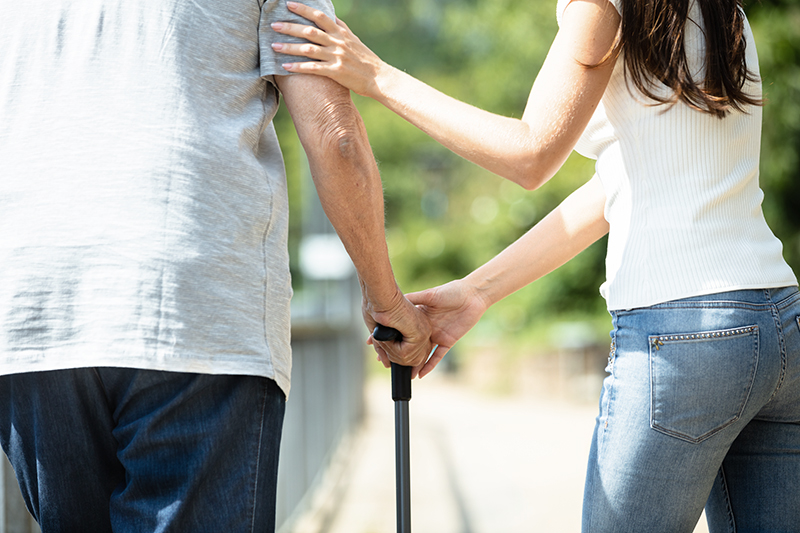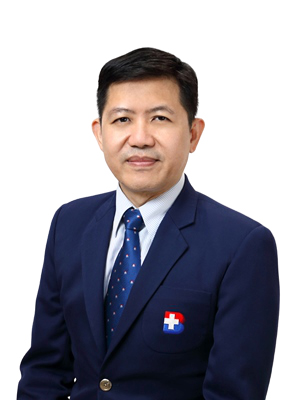Statistics forecast that Thailand became a complete aged society in 2021. Most Thai senior citizens have chronic health conditions and up to 5% cannot care for themselves, which make them dependent on their loved ones. The most common condition is caused by accidents inside their own home, such as broken hip and brain injury, which contribute to high rates of disability and mortality.
First Aid When Seniors Fall
The most common repercussion from an accidental fall in Seniors is broken hip and head trauma, which contribute to high rates of disability and mortality. The most common cause of accident among seniors between 65 – 75 years old is falling, such as slipping in the bathroom, falling from the bed, falling down the stairs. The perils come from multiple organ injuries involving the head, chest, stomach, back, hips, or limbs. Particularly if they have chronic condition or osteoporosis, they are more prone to broken bones and more severe injury.
First aid steps when seniors fall are:
- Assess life-threatening injuries, such as shock, traumatic brain injury, and spine injury
- Assess common injury, such as broken hip
- Prevent injuries during transport or movement to the hospital
- Emergency Medical Service will assess and give primary care as well as coordinate with the emergency doctor to prepare advanced trauma life support as necessary
If the seniors suffer from multiple injuries, it is necessary for a specialist, such as emergency medicine, trauma surgeon, neurosurgeon, orthopedic surgeon, or geriatrics medicine, etc., to get involved in the care plan. During the emergency, there is a guarantee timeline on the treatment and preparation for surgery for a good outcome.
Traumatic Brain Injury Requires Urgent Medical Attention
One problem that may arise during a fall in seniors is traumatic brain injury, which has a higher risk of intracranial bleeding. Elderly people tend to fall more readily because the nervous system and muscles coordination decayed. Walking slows down, the eyes are not as focused, hearing and memory begin to decline. Furthermore, vertigo may set in causing a fall easily. In addition, some elderly patients may be on anti-coagulants, such as warfarin (Coumadin), clopidogrel (Plavix), which cause prolonged bleeding when injured. There is also a risk of brain trauma or injury and intracranial bleeding.
Thus, elderly patients that suffer from head injury should receive medical attention as soon as possible. Indications for overnight observation in the hospital include level of consciousness, weakness in the extremities, blurred vision, headache, nausea, altered memory or behavior, etc. If the symptoms are severe, the doctor will consider X-ray computer CT or MRI. Then, a team of neurologist will check every 1 – 4 hours, depending on the severity of the injury. Some patients may require brain surgery to relieve pressure from intracranial bleeding. Others may suffer from brain trauma or injury that may not be an obvious bleeding, hence, the doctor may consider placing a microsensor to monitor if there is any increase in intracranial pressure.
Family members need to perform risk assessment of their senior after a fall by observing abnormalities as follows:
- Ability to see
- Ability to walk or control body balance
- Effects on memory, such as confusion, forgetfulness about date, time, place, or people, etc.
- Slow response and decision making
- Assess the living environment
Any family living with seniors should be careful. If they fall, please take them to the doctor for assessment whether they have broken any bone or suffer from head trauma or not. Because it is a life-threatening situation, do not shrug off imbalance as normal degeneration or chronic condition, such as dementia or depression. If they suffer from head trauma and become unconscious, keep them in the same position and call an ambulance. If the patient is conscious and have neck pain, let them lie flat without a pillow. Call the ambulance and refrain from movement.
Broken Bone from a Slip May Be Life-threatening
One of the problems that causes morbidity is a broken bone. The silent cause of a broken bone is osteoporosis because there is no warning sign and it is only discovered after a fall that breaks a bone. One in three elderly people tend to slip and fall, while half will fall more than once. When an elderly person falls, the worst-case scenario is that 20% of them will break their hip and risk of dying within one year. Therefore, any elderly person with a broken hip should receive prevention treatment after surgery.
Symptoms that indicate a broken hip after a fall are:
- Pain around the injured hip
- Inability to walk
- Cannot put weigh on the affected side
If you suspect your loved one may have broken their hip, let them rest in a comfortable position. Do not try to move them and call the ambulance as soon as possible.
Treatment of an elderly person who may have suffered from a broken bone due to a fall is focused mainly on the hip. The patient should receive treatment or surgery within 24 – 48 hours and co-managed by a multidisciplinary team of specialists, which includes a surgeon, an orthopedic surgeon, geriatrician, anesthesiologist, rehabilitation medicine, physical therapist, clinical pharmacist, nutritionist, and nurses, who will perform comprehensive assessment on the patient from the beginning from every aspect. They will also make a care plan together with the patient and family to help the patient back to health and walking in a short time.
The doctor will perform hip surgery known as minimally invasive osteosynthesis (MIPO) so that the patient will have less pain and decrease the risk of infection and blood loss. The patient will recover quicker, the bones will heal faster and the scar will be minimal. There is also a new technique for hip joint replacement surgery that does not require incision into the muscle. The patient will lose minimal blood, recover quicker, suffer from less pain after surgery and can return to their normal routine without worries when putting weight on their hip.
Rehabilitation Back to Health
Recovery, physical therapy and rehabilitation by a multidisciplinary team of specialists is an alternative to quickly nurse the patients back to their normal routine without being a burden on the family. Furthermore, the risk of complications and re-admission to the hospital will also decrease for patients who suffer from neurological problem, musculoskeletal system, problem with balance or movement. The doctor will assess the risk of another fall and plan a treatment program that focus on balance and movement.
Guidelines for fall prevention in elderly patients include
- Proper walk or movement
- Wearing suitable shoes
- Exercise to strengthen the muscles
- Balance exercise
- Assessment by Balance Master to determine the ability to perform daily routines
- Assessment of balance and center of gravity
Additionally, there is also aquatic treadmill to help elderly patients who have problem with balance, before or after joint, spine, or hip surgery. It will help reduce injury around the joints and muscles by changing the water level or using the Alter-G Treadmill, an equipment that uses an airbag to support up to 80% of the bodyweight. It is suitable for patients who cannot put weight on their legs, knees, ankles, or feet after the surgery. Particularly, overweight patient, athletes, or patients who want to get stronger can move their joints and muscles by using a walker or cane. They can also change their behavior, such as getting up slower than before to prevent sudden blood pressure drop in the standing position or blackouts. The patient should also fortify their health with good nutrition that include 5 food groups. If medication is necessary, please consult a doctor or pharmacist to assess the medication and avoid overuse in the case that the medication may interfere with balance.
Regaining Quality of Life
Rehabilitation for elderly patients who suffered from traumatic brain injury and broken hip will help them regain their quality of life. Daily routines may be limited after the surgery and balance may still be an issue. Thus, continuous rehabilitation will nurse them back to good health. Initially, they will need constant care once they return home to get regular physical therapy. Rearrange the living surroundings, such as getting an anti-slip mat for the bathroom, removing clutter, and providing enough light, especially around the stairs and dark walkways by keeping the light switch within reach, keeping only necessary appliances in sturdy, off the ground area that is easily visible without having to move them around often. The bed, chair, and toilet should be of an appropriate height. The stairs and walkways should have railing. The floor should be even and use non-slip mats especially in the bathroom. Connecting area should be on the same level. Avoid uneven door threshold. Do not put anything that people can trip over, such as a mat or power cord on the floor.
Medical service for wellness and rehabilitation is important for patients after surgery that requires physical therapy. They should be under the supervision of a team of specialists, such as internist, geriatrician, rehabilitation medicine, nurses, and physical therapists, nutritionist and coach, to provide continuous rehabilitation that will improve physical and mental health comprehensively so that the patient can return to their daily routine, care for themselves, or contribute to society better.
















